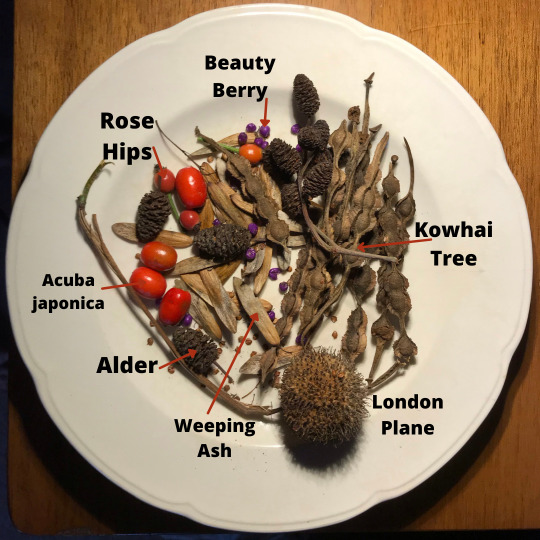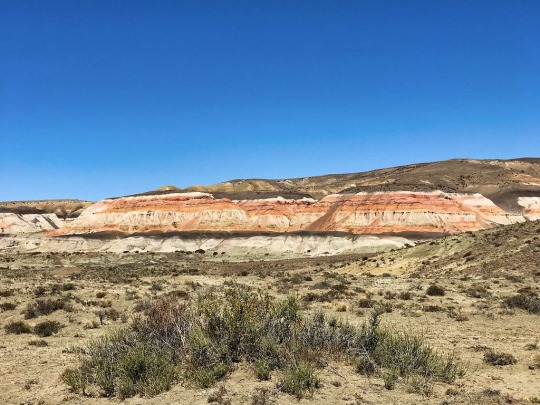#Stratification
Explore tagged Tumblr posts
Text

55 notes
·
View notes
Text
Blooming in Blue

Summers in the Barents Sea -- a shallow region off the northern coasts of Norway and Russia -- trigger phytoplankton blooms like the one in this satellite image. (Image credit: W. Liang; via NASA Earth Observatory) Read the full article
#flow visualization#fluid dynamics#mixing#physics#phytoplankton#satellite image#science#stratification
43 notes
·
View notes
Text

Seeds are miraculous little things if you ponder them... They contain the potential for a whole plant in a biological "time capsule". As gardeners in Europe and the Northern Hemisphere start planning their seed orders, it's a perfect time to learn more about germination. Germination is the term for an organism growing into a whole adult plant from a seed or a spore, and it is used scientifically to talk about fungi and bacteria as well as plants. A typical plant seed contains a plant embryo, food reserves, and a seed coat. Depending on the species, mature seeds can be stored for years since the plant embryo is in a dehydrated state of suspended animation.
In nature, germinating at the wrong time in unfavourable conditions could spell disaster for the new plant. Seeds rely on the signals from water, temperature, oxygen, and light.
Soaking seeds is an excellent way to start germination. The seed coat is gently scarified with sandpaper or a nail file to break the watertight seal and allow water to enter the seed interior. The seeds often double in size as their tissues soak up the water in a process called imbibition. Water activates hydrolytic enzymes which start the seed's biological metabolism.
Tree seeds from temperate climates usually need cold stratification to germinate. The seed is kept in soil at low temperatures around 4 C (like a fridge) for several months before returning to room temperature. This temperature change tells the seed winter has passed and spring has arrived. Simply leaving potted seeds in a cold frame overwinter is ideal in Europe.
Seeds along need oxygen since seedlings do aerobic respiration until they're mature enough to start photosynthesising. Hard packed or waterlogged soil may contain insufficient oxygen and stop seeds from sprouting. Many tree seeds need exposure to light through a thin layer of soil to let them know that there's a "clearing" in the forest.Most kitchen garden seeds do well with soaking and exposure to warm temperatures since they are originally tropical plants.
This plate of seeds was collected in January in Hyde Park, London.
#seeds#germination#seedstarting#PlantBiology#plantscience#seedstorage#stratification#TreeSeeds#katia_plantscientist#gardening#gardeningtips#plants#plantfacts#stratification#seedsaving#seedstartingtime#semillos#nuts#fruits#plantlife
#katia plant scientist#botany#plant biology#plants#plant science#seeds#seed starting#seed saving#stratification#seed collecting#plant#plant aesthetic#plant scientist#plantblr#plantcore#planting#gardening#tree seeds#gardening tips
22 notes
·
View notes
Text
i have compiled some native plant gardening tips for those of whom are new to it based on my own experiences and trials and errors, so here goes:
if you're germinating seeds, dont use coco coir. it sucks. ignore anyone who tells you to use it. it doesnt hold moisture well at all and doesnt decompose well. look for a "seed starter" soil instead, it will have a bunch of beneficial nutrients n such to get the seeds and their roots going. if you're concerned about peat, there are plenty out there that don't have any, coast of maine comes to mind. I used to think I needed to grow them in a sterile env, mostly to prevent mold, but I find that nearly impossible to avoid, so on to my next tip:
you're better off trying to start your native seeds outside. even if you wanna use cell trays, thats fine (bring them in when it freezes though), but preventing mold when germinating inside, especially in your fridge with all your food you sometimes forget is there and gets moldy, i've found to be nearly impossible. granted, mold isnt always a bad thing, it can help eat the seed coating so the roots can grow, but this obviously isnt true for all seeds and especially not small seeds. outside is your best bet, I just find less mold grows out there. might be good to make a mini green house of sorts to keep your seed trays in, obviously thats unnecessary if you're growing them in the ground.
if you're like me and have no real ground space and only have a patio or balcony and have to grow everything in pots, I have a couple tips for you actually, but for now lets focus on winter protecting your plants. most suggest burying them under ground... im assuming like me that isn't really an option for you, so we're gonna come up with another solution. you're probably going to need to invest a good amount of money into this, depending on if you have the material around or not. but to start off:
huddle all your pots together. they can help insulate eachother better and keep eachother warm. i try to put the least cold hardy ones in the center, if you can, put them all together in a larger container like a bucket or something and cover it with lots of mulch. water sparingly and lightly, enough to wet the soil but not enough to drip through the bottom of the pot. you should be sparingly watering anyways in winter, but especially so here since they'll probably be in a container that doesnt drain unless you want to drill in holes on the bottom. try to make sure the pots dont touch the sides of the containers if they're plastic and fill in the gaps with mulch or something, plastic isnt the best material to use for pots regardless, unfortunately its the cheapest and most readily available and comes in varying sizes so I cant get mad at you for using it.
heavily mulch your plants. maybe put some straw on top of the mulch too if you have any. I used to think leaves were enough but there's too much airy space between them, you want to make the insulation as compact as possible. if you're wanting to make a place for bumblebees to hibernate i'd suggest making an entirely different leaf pile or something unrelated to your plants. (obv doesnt apply to ppl growing stuff in the ground bc you have the privilege of being able to sprinkle leaves wherever you want. bastard.)
invest in some burlap fabric and some cheap towels or blankets for even more insulation, the fuzzier the blanket the better imo, but it should be fine whatever you choose, just try not to get too thin of a fabric. the burlap and blanket/towel might not be necessary to use every day but definitely on days where its below freezing. these also will last you every year, assuming you take care of them right. cover the tops of pots but also wrap around the sides of them and maybe put a layer or two of burlap down on the ground under them, esp if they're on cold hard concrete.
if you have any plants with tuberous roots, they are more vulnerable to freezing if they're in a pot and will need extra protection or to be brought inside during a freeze, to not shock it with a temperature shift try putting the pot in the fridge if you can, otherwise again it might be good to try to make a mini green house of sorts, maybe turn one of those plastic window well covers into one? or put it in a garage if you have something like that. they also, maybe obviously but just in case, dont need to be watered as often since they have lots of water stored in themselves.
putting your pots really close to the walls of your house can also help keep them warm. not sure if its enough to prevent them from freezing but combined with everything else? well, it's survived many of my plants over the last couple years (though i didnt know about the tuber thing until recently and it explains so much why certain plants didnt make it >_>)
ok moving on from winter. lets go back to talking about pots, bc seriously if you can get your hands on ANYTHING besides a plastic pot, jump on it. they suck universally. they suck in winter and in summer. their only benefit is providing some humidity but that's not really something I personally need as someone in a temperate climate. also, the lighter the pot the better. dark plastic pots can cook the roots of your plants in the sun in summer so you have to be extra careful. also, the deeper the pot the better for native plants.
because you're growing native plants in pots, they're going to need a lot more extra care. native plants in the ground can pretty much be neglected since nature takes care of it all, but you have to provide the water, soil, fertilizer, etc. so lets talk about that:
you dont need to water every day necessarily, the old trick of watering when the top 1-2 inches is dry is your best method to go by. if you live in the midwest or northeast or anywhere it gets heavy rain, it would be good to give them a deep watering every now and then, I try to follow what the rain does and water at the same frequency as it. it would be good to water daily (maybe only a small amount if the soil is still somehow wet) on really hot days even though you dont have to water every day, like on days above 90 degrees. also the best time to water, especially in summer, is early in the morning, ideally some time before 8, 9 is ok but 8 is better imo bc it gives the roots more time to absorb the water before the sun evaporates it, and around 10 is when that starts happening. if you have to water at night, water early at night and try to avoid watering the leaves if you can as water left over on them overnight can cause mold, mildew or other diseases. if you have to water mid day, at least wait until the sun isnt directly on the plants so they can actually absorb some of the water.
since you have to provide your own water and cant rely on rain, you also have to provide your own fertilizer. I mean you already did before, but I mean liquid fertilizer. rain transfers all kinds of vitamins and minerals to the plants that receive it, but you're likely not getting nearly as much in your tap, and since your pots likely aren't being shat in by various woodland creatures, they're getting even less fertilizer. so you have to provide the fertilizers, both slow and liquid. I thought I could just get by with slow release but the plants seem to do better with liquid too, especially when in bloom. if you use slow release you dont need to use the liquid fertilizer as often, and you also likely dont have to use the liquid as frequently as it says on the bottle, since native plants generally require less nutrients to begin with, but of course this is something you'll probably have to test on your own to see how much your plants want and tolerate. I have a whole feeding schedule I can share if you want. some brands I've been using for liquid fertilizer are foxfarm (they have good soil too), microlife, and maxsea (technically a powder but you mix it with water) and for slow release is foxfarm again, jobe's organics, and lilly miller's. I'm trying to use as organic of materials as I can since I'm growing the plants for native wildlife and pollinators and I dont want to negatively effect them as much as possible. if anyone wants to know what products I use specifically hmu or leave a reply.
I trust you're able to figure out your soil situation on your own, but here's some tips just in case: try to avoid brands like miracle grow since I'm pretty sure it has inorganic materials in it, generally I'd aim for the most organic thing you can find, assuming you're growing native plants for the same reason I am, for nature. also, take those messages about well-draining soil seriously, you can use perlite but also some soils are just lighter than others, I find foxfarms is pretty light and drains well.
during winter, leave the plants as they are, dont cut them down. lots of bugs and animals have made nests or homes or have cocoons n such in there. you can cut it down in the spring when frost is nor longer a concern, but dont throw it in the trash either bc the bugs might still be sleeping in them but will be less vulnerable now that winter is gone.
ok that's all I can think of for now, I'll add on to this if I think of anything else, but hopefully this is helpful for someone out there :]
#gardening#native plant gardening#gardening tips#germinating#stratification#pollinator garden#patio garden#balcony garden
8 notes
·
View notes
Text
SOME OF THOSE THAT WORK FORCES.
ARE THE SAME THAT BURN CROSSES.
Keep watching, keep learning, keep speaking about the crimes against humanity committed by the world's wealthy elite. Just because you sleep comfortably does not make you innocent. The powerful and plentiful of the EU and North America fund the crises in Palestine, in Congo, and in Sudan.
Do NOT desensitise yourself to atrocities committed around the globe, do NOT over-consume traumatic and disturbing materials of human suffering, do NOT stop at reblogging, and DO NOT DISENGAGE OR DROP-OUT. DO keep reading about the history, listen to the words spoken by the people on the ground and who are there, bring it up at the dinner table, normalise politics in the tearoom, spread kindness, wellness and be grateful for what you have.
#colonialism#post capitalism#indigenous#palestine#sudan#congo#rare earth minerals#metallurgy#open science#open access#new zealand#aotearoa#conservative#judaism#islam#christianity#catholocism#bureaucrats#stratification#gentrification#fauxmoi
34 notes
·
View notes
Text

TSRNOSS. Page 299.
#stratification#lakes#saline solution#thermal conductivity#Stickland reaction#McKay Effect#vinegar production#fumarate respiration#electrolytic reduction#glucose#sorbitol#aconitase#Aspergillus#energy charge of a cell#catabolic enzymes#methanol#alkanes#bacterial fuels#red tide#bacterial spore
0 notes
Video
Hidden Curriculum #1 by Russell Moreton Via Flickr: russellmoreton.blogspot.com/
#Teaching Academy#Brockwood Park School 2011 learning environment drawing situation research dialogues participants#library#material#books#charts#glass#lead#terracotta#clay#wood#russell moreton#stratification#interests#inquiry#intelligence#praxis#practice#assemblages#collections#compositions#relationships#drafts#forms hard to name#components#registers#references#lines#discursive spatial practices#a-discursive ---practice-
1 note
·
View note
Text

#argentina#stratification#geology#passing of time#landscape photography#landscape#outdoors#blue sky#michele molinari
0 notes
Text
youtube
From Seed to Tree
0 notes
Text
How representative is it really? A correspondence on sortition
A few months ago, Paolo Spada and I published a blog post about sortition and the representativeness of citizens’ assemblies. We were pleasantly surprised by the response to our post and the ensuing discussions. In this new exchange at the Deliberative Democracy Digest, Kyle Redman, Paolo Spada, and I try to delve deeper, exploring further the challenges of achieving representativeness in…

View On WordPress
#citizens&039; assemblies#deliberative democracy#intersectionality#mini-publics#representativeness#sortition#statistical representation#stratification
1 note
·
View note
Text
Waiting on all my plants right now like stratify faster
0 notes
Text







Michelle Thompson 🎨 @artistmichellethompson
The Time Machine, oils on stretched canvas, 62" × 54"
701 notes
·
View notes
Text


#homelessness#social mobility#wealth gap#media manipulation#millionaire#economic disparity#income inequality#class consciousness#working class#brainwashing#class status#social inequality#wealth distribution#billionaire#social stratification#economic mobility
160 notes
·
View notes
Text
instagram
Cool new way to guerrilla garden?
SFinBloom’s Instagram caption below
Here’s a fun way to plant seeds. Not sure what to call them. People get so excited about planting in spring when they see all the spring blooms. Spring blossoms need time to germinate. Seeds not only weather the cold well, some seeds actually require it. Many plant seeds require being cold for a period of time, or cold stratification, to prevent seeds from germinating before winter sets in. Here’s a fun and easy way to cold stratify your plants while making them easy to plant. Its like seed bombs but with ice instead of mud or clay.
#guerrilla gardening#sfinbloom#gardening#outdoor gardening#solarpunk#action#growing from seed#wildflowers#cold stratification#out of queue#ani rambles#i… guess?#its not my original concept I’m just sharing it with yall#Instagram
135 notes
·
View notes
Text
The way it's depicted, Cybertron's pre-war societal issues had a lot less to do with Functionism and more to do with unchecked government corruption, massive wealth disparity, high layoff/unemployment rates, and disenfranchisement.
People were starving, they needed work, they weren’t getting any. Those that were fortunate enough to have work didn’t get paid living wages, much less have anything to spare for health contingencies. Even then stability’s still the luxury of the top few tiers; they live one cut away from layoff. The government cared only enough to exacerbate these issues by coming up with new ways for exploitation. Any attempts to protest or lobby were shut down through political persecution. As a result the masses turned increasingly to crime, drug abuse, thuggery, and violence. Extreme acts of terrorism gets lauded as long as the collateral damage's suffered by someone else. Morality and caution are eroded in the face of desperation.
Meanwhile the many alleged restrictions of Functionism are just lip service complaints made by the characters which doesn’t match up to most of the stuff we’re shown. Like if Rung could become a psychologist, a specialized job that requires higher education, despite having zero background on top of such a weird alt that he had to be classified as an ornament, then wow the functionists must be open-minded. If Dominus Ambus could be a scientist/doctor/explorer/author/successful social rights advocator during the height of functionist control with a minesweeper military-use alt (assuming that his secondary alt's the same as Minimus'), then wow the functionists must be accommodating. If Tyrest could become chief engineer under Nova and later go into law, a complete change of profession, while being a jet, then wow functionism's flexible. If Ratbat and Momus could become senators in a society that discriminates heavily against beastformers and labor frames, then wow that’s progressive. If every Prime from Nova to Zeta (with the exception of Sentinel, his alt’s a tank, he only has wings in Megatron Origin as part of his Apex armour upgrade), every single named pre-war senator other than Proteus and Momus, and four out of five of Nova Prime’s buddy club (only Galvatron's a grounder) were wingframes in a society that supposedly discriminates against wingframes, then wow that’s… inconsistent worldbuilding.
Megatron didn’t get into bloodsports or start a war because he didn’t get to pursue his dream job. He got driven into the pits and down the slippery slope of moral degeneration because his only source of income was cut off by the mine closure incident. People wanted livelihoods above anything else, it's the failure to provide that that made the miners go off the deep end and resulted in the death of a guard. If Functionism actually ensured that everyone could be guaranteed a job or at least minimized the unemployment rates, then stratified castes or not, there would have been no war. People, or societies, are generally capable of tolerating an incredible amount of injustice as long as the majority still have a chance at scraping by at the end of the day. But the government, and later Megatron, kept yanking the rug out from under everyone over and over until they no longer even had a chance at that; there's no other choice left but fight or die.
#I get that all prejudices are full of contradictions and inconsistencies meant to cater to the needs of the ruling class#for the sole purpose of upholding the social stratification#and tokenism is a common thing#but when you can pull out two or more examples as shown to the contrary for every one of a character's complaints#about how they suffered from functionism discrimination#then it's just a really bad case of inconsistent writing with all tell no show#like you cannot expect me to take the 'flightframes are low caste' thing seriously#because the entire pre-war upper class is almost exclusively comprised of flight frames. it's the ground vehicles that are the minority#honestly it just feels like something made up on the spot for Starscream's sake#and Thundercracker Skywarp Jetfire got benefitted by association#when was functionism introduced as a concept in the comic anyway#was it in that Megatron/Optimus conversation in Chaos Theory?#b/c I'm getting heavy retcon vibes there#I got no impression that functionism was even a thing that existed when reading Megatron Origin#Autocracy's written later but still no functionism#The main social issue is widespread poverty like I'm sure a lot of those ppl would be pretty happy if someone could assign them jobs?#the miners in Megatron Origin weren't mad because they had to work in the mines#They were mad because of the layoff and automation and knowing soon there's going to be no mines for them to work. and then they'd starve#idw transformers#transformers#maccadam
60 notes
·
View notes
Video
Hidden Curriculum #2 by Russell Moreton Via Flickr: russellmoreton.blogspot.co.uk/ Speculative Learning Environment : Russell Moreton. Re- Imagining Education, Brockwood Park School. a thousand plateaus Deleuze, Guattari Assemblage Becoming Body Without Organs Nomad Rhizome Smooth Space State War Machine www.rhizomes.net/issue5/poke/glossary.html
#Teaching Academy#Brockwood Park School 2011 learning environment drawing situation research dialogues participants#library#material#books#charts#glass#lead#terracotta#clay#wood#russell moreton#stratification#interests#inquiry#intelligence#praxis#practice#assemblages#collections#compositions#relationships#drafts#forms hard to name#components#registers#references#lines#discursive spatial practices#a-discursive ---practice-
1 note
·
View note